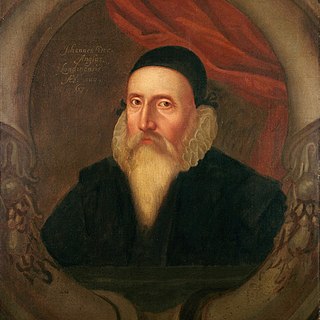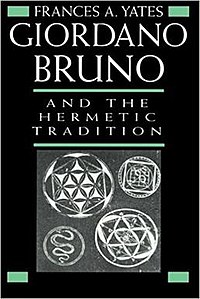
Giordano Bruno was an Italian philosopher, poet, cosmological theorist and esotericist. He is known for his cosmological theories, which conceptually extended to include the then-novel Copernican model. He proposed that the stars were distant suns surrounded by their own planets (exoplanets), and he raised the possibility that these planets might foster life of their own, a cosmological position known as cosmic pluralism. He also insisted that the universe is infinite and could have no center.

Hermes Trismegistus is a legendary Hellenistic period figure that originated as a syncretic combination of the Greek god Hermes and the Egyptian god Thoth. He is the purported author of the Hermetica, a widely diverse series of ancient and medieval pseudepigraphica that lay the basis of various philosophical systems known as Hermeticism.
Christian views on magic vary widely among Christian denominations and among individuals. Many Christians actively condemn magic as satanic, holding that it opens the way for demonic possession. Some Christians simply view it as entertainment. Conversely, some branches of esoteric Christianity actively engage in magical practices.

Hermeticism or Hermetism is a philosophical and religious system based on the purported teachings of Hermes Trismegistus. These teachings are contained in the various writings attributed to Hermes, which were produced over a period spanning many centuries and may be very different in content and scope.

Heinrich Cornelius Agrippa von Nettesheim was a German Renaissance polymath, physician, legal scholar, soldier, knight, theologian, and occult writer. Agrippa's Three Books of Occult Philosophy published in 1533 drew heavily upon Kabbalah, Hermeticism, and neo-Platonism. His book was widely influential among esotericists of the early modern period, and was condemned as heretical by the inquisitor of Cologne.

Alan Charles Kors is an American historian who is the Henry Charles Lea Professor Emeritus of History at the University of Pennsylvania, where he taught the intellectual history of the 17th and 18th centuries. He has received both the Lindback Foundation Award and the Ira Abrams Memorial Award for distinguished college teaching. Kors graduated A.B. summa cum laude at Princeton University in 1964, and received his M.A. (1965) and Ph.D. (1968) in European history at Harvard University.

Summis desiderantes affectibus, sometimes abbreviated to Summis desiderantes, was a papal bull regarding witchcraft issued by Pope Innocent VIII on 5 December 1484.

Dame Frances Amelia Yates was an English historian of the Renaissance, who wrote books on the history of esotericism.
The Formicarius, written 1436–1438 by Johannes Nider during the Council of Florence and first printed in 1475, is the second book ever printed to discuss witchcraft. Nider dealt specifically with witchcraft in the fifth section of the book. Unlike his successors, he did not emphasize the idea of the Witches' Sabbath and was skeptical of the claim that witches could fly by night. With over 25 manuscript copies from fifteenth and early sixteenth century editions from the 1470s to 1692, the Formicarius is an important work for the study of the origins of the witch trials in Early Modern Europe, as it sheds light on their earliest phase during the first half of the 15th century.

Giovanni Francesco Pico della Mirandola (1470–1533) was an Italian nobleman and philosopher, the nephew of Giovanni Pico della Mirandola. His name is typically truncated as Gianfrancesco Pico della Mirandola.

John Dee was an English mathematician, astronomer, teacher, astrologer, occultist, and alchemist. He was the court astronomer for, and advisor to, Elizabeth I, and spent much of his time on alchemy, divination, and Hermetic philosophy. As an antiquarian, he had one of the largest libraries in England at the time. As a political advisor, he advocated the foundation of English colonies in the New World to form a "British Empire", a term he is credited with coining.

Hermetic Qabalah is a Western esoteric tradition involving mysticism and the occult. It is the underlying philosophy and framework for magical societies such as the Golden Dawn, has inspired esoteric Masonic organizations such as the Societas Rosicruciana in Anglia, is a key element within the Thelemic orders, and is important to mystical-religious societies such as the Builders of the Adytum and the Fellowship of the Rosy Cross.

Renaissance magic was a resurgence in Hermeticism and Neo-Platonic varieties of the magical arts which arose along with Renaissance humanism in the 15th and 16th centuries CE. During the Renaissance period, magic and occult practices underwent significant changes that reflected shifts in cultural, intellectual, and religious perspectives. C. S. Lewis, in his work on English literature, highlighted the transformation in how magic was perceived and portrayed. In medieval stories, magic had a fantastical and fairy-like quality, while in the Renaissance, it became more complex and tied to the idea of hidden knowledge that could be explored through books and rituals. This change is evident in the works of authors like Spenser, Marlowe, Chapman, and Shakespeare, who treated magic as a serious and potentially dangerous pursuit.
White magic has traditionally referred to the use of supernatural powers or magic for selfless purposes. Practitioners of white magic have been given titles such as wise men or women, healers, white witches or wizards. Many of these people claimed to have the ability to do such things because of knowledge or power that was passed on to them through hereditary lines, or by some event later in their lives. White magic was practiced through healing, blessing, charms, incantations, prayers, and songs. White magic is the benevolent counterpart of malicious black magic.
Throughout the era of the European witch trials in the Early Modern period, from the 15th to the 18th century, there were protests against both the belief in witches and the trials. Even those protestors who believed in witchcraft were typically sceptical about its actual occurrence.
Nicholas Jacquier was a French Dominican and Inquisitor. He became known as demonologist and proponent of witch-hunting.
De Umbris Idearum is a book written in 1582 by Italian Dominican friar and cosmological theorist Giordano Bruno. In this book, he proposes a system integrating mnemonics, Ficinian psychology, and hermetic magic. It is the first book he wrote covering the subject of memory, a topic on which he would focus the rest of his works.
Edward Murray Peters is an emeritus professor of University of Pennsylvania who specialized in the religious and political history of early Europe. He has done in-depth research regarding heresy, repression and the limits and treatment of intellectual inquiry in the low Middle Ages. He has also done deep research on historiography criticising, improving and reviewing the methods that traditional historiography has applied to the low medieval time period.
The history of magic extends from the earliest literate cultures, who relied on charms, divination and spells to interpret and influence the forces of nature. Even societies without written language left crafted artifacts, cave art and monuments that have been interpreted as having magical purpose. Magic and what would later be called science were often practiced together, with the notable examples of astrology and alchemy, before the Scientific Revolution of the late European Renaissance moved to separate science from magic on the basis of repeatable observation. Despite this loss of prestige, the use of magic has continued both in its traditional role, and among modern occultists who seek to adapt it for a scientific world.








